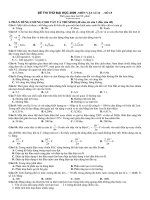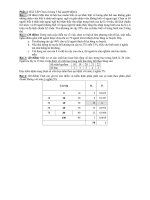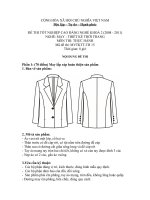15 ellman auxiliary
Bạn đang xem bản rút gọn của tài liệu. Xem và tải ngay bản đầy đủ của tài liệu tại đây (886.6 KB, 6 trang )
Myers
Synthesis of Chiral Amines by Asymmetric Additions to tert-Butylsulfinimines (Ellman Auxiliary)
Chem 115
tert-Butylsulfinamide:
Recent Reviews:
Robak, M. T.; Herbage, M. A.; Ellman, J. A. Chem. Rev. 2010, 110, 3600–3740.
• The advantages of tert-butylsulfinamide over related arenesulfinamides include ease of substrate
synthesis, enhanced stereoselectivity, and reduction in side-reactions (e.g., addition at sulfur).
Ferreira, F.; Botuha, C.; Chemla, F.; Pérez-Luna, A. Chem. Soc. Rev. 2009, 38, 1162–1186.
Zhou, P.; Chen. B.-C.; Davis, F. A. Tetrahedron 2004, 60, 8003–8030.
• Both enantiomers are readily available at reasonable prices (<$1/g in bulk quantities) and can be
synthesized catalytically on 90-g scale in the laboratory in excellent yield and enantiopurity.
• Davis first reported the synthesis of racemic p-toluenesulfinimines in 1974. Later, Davis
demonstrated the 1,2-addition of organometallic reagents to enantioenriched ptoluenesulfinimines en route to enantioenriched amino acid derivatives and aziridines.
Sulfinimine Synthesis:
• In 1997, Ellman reported the enantioselective synthesis and application of tertbutanesulfinamide for the preparation of enantioenriched amines.
OH
Generalized Reaction Scheme:
H
N
O
R1
S
R2
Typically:
t-Bu
O
N
+
R1
R4 M
R3
S
R2
S
S
O
R VO(acac)2
t-Bu +
30% H2O2
acetone
t-Bu
S
S
R = 2-hydroxy-3,5-ditert-butylphenyl
NH
R4
R3
• R1 = p-tolyl (Davis), tert-butyl (Ellman).
• R4 = alkyl, aryl, heteroaryl
• M = Li, MgBr
• R2, R3 = H, alkyl, aryl, heteroaryl
t-Bu
1. Li, NH3, THF,
Fe(NO3)3•9H2O
O
t-Bu
2. ClCH2COOH,
ice
3. Recrystallize
S
NH2
72% from
disulfide
99% ee
• Condensation of tert-butylsulfinamide with a significant excess of an aldehyde in the
presence of MgSO4 and p-toluenesulfonate, as originaly reported, affords the corresponding
tert-butylsulfinimine with no racemization at sulfur.
Weix, D. J.; Ellman, J. A. Org. Synth. 2005, 82, 157–165.
Mechanism:
• Coordination between oxygen and the metal center in a chair-like transition state has been invoked
to explain the observed sense of stereochemical induction as seen in the example below:
O
t-Bu
O
t-Bu
S
H
N
+
Et
Br
CH2Cl2
O
!48 °C
t-Bu S
PhMgBr
O
Mg Ph
N
Et
H
t-Bu
S
Ph
S
+
NH2
O
H
R
(2!3 equiv)
MgSO4 (5 equiv)
PPTS (0.05 equiv)
CH2Cl2, 23 °C
t-Bu
O
S
H
N
R = Ph, 91%
R = Et, 96%
R R = i-Pr, 90%
NH
Et
100%, 92% de
Liu, G.; Cogan, D. A.; Ellman, J. A. J. Am. Chem. Soc. 1997, 119, 9913–9914.
Liu, G.; Cogan, D. A.; Ellman, J. A. J. Am. Chem. Soc. 1997, 119, 9913–9914.
Jonathan William Medley
1
Myers
• The use of CuSO4 as a Lewis acidic promoter gives a high yield of the tert-butylsulfinimine without
the need for a large excess of aldehyde, and Ti(OEt)4 leads to smooth condensation even in the
case of highly recalcitrant aldehydes.
O
t-Bu
S
O
CuSO4 (2 equiv)
H
R
(1.1 equiv)
CH2Cl2, 23 °C
+
NH2
R = Ph, 91%
R = i-Pr, 90%
t-Bu
N
R= 4-MeOPh, 85%
R = t-Bu, trace
H
R
R = 3-pyridyl, trace
Synthesis of enantioenriched primary amines:
• Addition of Grignard reagents to enantioenriched tert-butanesulfinyl aldimines affords the
corresponding sulfinamides typically in high yield and with high diastereoselectivity;
subsequent HCl-promoted solvolysis in methanol and precipitation with Et2O affords the
corresponding primary amine•HCl salts.
O
S
O
t-Bu
O
S
N
O
S
O
+
NH2
H
R
(1.1 equiv)
Ti(OEt)4 (2 equiv)
t-Bu
THF, 23 °C
O
S
H
N
R = Et, 100%
R = t-Bu, 82%
R R = 3-pyridyl, 100%
O
O
t-Bu
S
O
+
NH2
R1
R2
(1.1 equiv)
Ti(OEt)4 (2 equiv)
THF, 60!75 °C
t-Bu
S
R1
N
R2
Liu, G.; Cogan, D. A.; Owens, T. D.; Tang, T. P.; Ellman, J. A. J. Org. Chem. 1999, 64, 1278–1284.
!48 °C
S
HCl
NH
R1
R2
CH3OH
NH3
Cl
R1
R2
R2
sulfinamide yield (%)
dr
amine•HCl yield (%)
Et
CH3
96
93:7
97
Et
Ph
100
96:4
90
Et
100
97:3
93 (85)a
i-Pr
Ph
98
89:11
91 (76)a
Ph
Et
98
92:8
94
Ph
H2CCH
79
94:6
93
Bn
CH3
89
95:5
95
Bn
Ph
81
95:5
99
4-MeOPh
Et
88
99:1
100
yield of enantiomerically pure material after a single recrystallization.
• The use of CH2Cl2 as solvent was found to be optimal, while the use of ethereal solvents such
as Et2O or THF gave reduced stereoselectivity, presumably due to binding to the magnesium ion
to promote the open transition state as a competitive pathway.
O
S
H
Br
Mg R2
t-Bu S N
O
t-Bu
• While tert-butanesulfinyl aldimines are generally robust, tert-butanesulfinyl ketimines are
more sensitive to moisture. Though they can be handled in air and quickly chromatographed
with hexanes/Et2O as eluent, they should be stored dry at !5 °C.
t-Bu
R1
aisolated
R1 = Me, R2 = Ph, 100%, single
isomer
R1 = n-Bu, R2 = i-Pr, 77%, single
isomer
R1 = Me, R2 = t-Bu, 82%, single
isomer
R1 = Me, R2 = i-Bu, 88%, 6 : 1 E/Z
R1 = Me, R2 = n-Bu, 77%, 5 : 1 E/Z
R2MgBr
CH2Cl2
i-Pr
Liu, G.; Cogan, D. A.; Owens, T. D.; Tang, T. P.; Ellman, J. A. J. Org. Chem. 1999, 64, 1278–1284.
Ketimine Synthesis: The more challenging task of condensation of tert-butylsulfinamide with a
ketone can be achieved using Ti(OEt)4 at elevated temperatures. When R1 and R2 are similar in size,
an equilibrating mixture of isomers is formed.
+
R1
H
t-Bu
Chem 115
Synthesis of Chiral Amines by Asymmetric Additions to tert-Butylsulfinimines (Ellman Auxiliary)
R1
t-Bu
R2
H
N
+
R1
R2MgBr
O
S
NH
R1
closed TS
H3C
H3C
H3C
O
N
H
R1
R2MgBr
open TS
t-Bu
O
S
R2
NH
R1
Jonathan William Medley
2
Myers
Chem 115
Synthesis of Chiral Amines by Asymmetric Additions to tert-Butylsulfinimines (Ellman Auxiliary)
Use of Ketimine Electrophiles:
Additions to tert-Butylsulfinimines via Open Transition States:
• While addition of phenyl Grignard to a ketimine substate in the example below proceeded
with low stereoselectivity and with a reversed sense of addition, the use of PhLi in toluene
gave excellent stereoselectivity.
• The use of weakly coordinating metal counterions such as lithium, certain Lewis acid or base
additives, or the presence of Lewis basic functional groups within the sulfinimine or
organometallic reactant can disrupt chelation control, and can lead predominantly to products
consistent with an open transition state.
• Of several Lewis acid additives examined, Al(CH3)3 was found to provide optimal yield and dr:
t-Bu
O
S
+
N
solvent
PhM
additive
i-Pr
H3C
t-Bu
O
S
NH
Ph
i-Pr
H3C
M = MgBr, CH2Cl2: 21%, 31 : 69 dr
M = Li, PhCH3: 65%, 94 : 6 dr
M = Li, PhCH3, Al(CH3)3: 93%, 97 : 3 dr
• The Lewis basic acetal group promotes open transition states in the transformation below,
part of a route to enantioenriched 2-substituted pyrrolidines.
t-Bu
O
S
H
• Optimized conditions were found to work well for a variety of ketimine and organolithium
substrates.
• In the case of ketimines that were mixtures of geometric isomers, the product dr was found to
exceed the substrate dr. It is proposed that the less stable, and less reactive, double bond
stereoisomer is converted to the major isomer under the reaction conditions.
N
+
t-Bu
R1
N
+
R2
Al(CH3)3
R3Li
PhCH3
!78 °C
(CH3)3Al
O Li R3
t-Bu S N
t-Bu
R2
R1
R1
R2
R3
yield (%)
dr
CH3
i-Pr
n-Bu
61
n-Bu
i-Pr
Ph
82
91:9
CH3a
n-Bu
Ph
93
89:11
CH3b
i-Bu
Ph
62
85:15
CH3
2-Npth
Ph
62
99:1
99:1
aThis
imine was used as a 5:1 mixture of double bond diastereomers.
bThis imine was used as a 6:1 mixture of double bond diastereomers.
Liu, G.; Cogan, D. A.; Ellman, J. A. J. Am. Chem. Soc. 1997, 119, 9913–9914.
Cogan, D. A.; Liu, G.; Ellman, J. A. Tetrahedron, 1999, 55, 8883–8904.
THF
t-Bu
!48 °C
95%, dr = 9 : 1
O
S
O
NH
O
TFA, H2O
Et3SiH
92%
Ph
HN
Ph
Brinner, K. M.; Ellman, J. A. Org. Biomol. Chem. 2005, 3, 2109–2113.
• Coordinating groups within the sulfinimine substrate can also favor an open transition state.
O
S
N
+
THF
i-PrMgBr
N
H
O
S
NH
R3
R1
R2
O
BrMg
Ph
t-Bu
O
S
O
72%, dr = 15 : 1
t-Bu
O
S
NH
N
i-Pr
Kuduk, S. D.; DiPardo, R. M.; Chang, R. K.; Ng, C.; Bock, M. G. Tetrahedron Lett. 2004, 45,
6641–6643.
• Lewis acid or base (TMEDA) additives favored an open transition state in this example from
a synthesis of the CNS inhibitor (R)-DDMS.
O
t-Bu
S
H
O
N
Cl
THF
t-Bu
+ i-BuLi
BF3•OEt2
!78 °C
S
i-Bu
NH
Cl 1. HCl,
MeOH
2. NaOH
H2N
Cl
i-Bu
90%
Han, Z.; Krishnamurthy, D.; Pflum, D.; Grover, P.; Wald, S. A.; Senanayake, C. H. Org. Lett.
2002, 4, 4025–4028.
Jonathan William Medley
3
Myers
Synthesis of Chiral Amines by Asymmetric Additions to tert-Butylsulfinimines (Ellman Auxiliary)
Chem 115
Diastereoselective Allylations of Enantioenriched Sulfinimines:
Additions of Enolates to tert-Butanesulfinimines:
• The proposed transition state for allylation involves coordination of both imino nitrogen and
sulfinyl oxygen to metal.
• The addition of ester enolates to tert-butanesulfinimines provides ready access to
enantioenriched !-amino acid derivatives.
• Commonly used allylmetals for additions to sulfinyl imines include Mg, In, and Zn.
• Optimized conditions involve in situ generation of the titanium enolate with an excess of
chlorotitanium triisopropoxide, followed by addition of the sulfinimine.
t-Bu
O
S
t-Bu
M
N
R1
R1
S
R2
t-Bu
N
O
M
O
S
NH
R1
R2
R2
• The stereochemical outcome can be rationalized by invoking a Zimmerman#Traxler transition
state with chelation of the sulfinimine to titanium.
O
S
t-Bu
O
N
R2
M
yield
dr
CH3
Ph
MgBr
85%
>99:1
CH3
i-Pr
MgBr
93%
>95:5
H
C9H19
MgBr
77%
91:9
H3 C
Cogan, D. A.; Liu, G.; Ellman, J. Tetrahedron 1999, 55, 8883.
Bertrand, M. B.; Wolfe, J. P. Org. Lett. 2006, 8, 2353.
H
N
+
R
In (4 equiv)
Br
t-Bu
S
O
O
O
N
R1
R2
TiLn
O
CH3
R1
R2
yield (%)
dr
i-Pr
H
85
98 : 2
3-pyr
H
70
95 : 5
i-Pr
CH3
85
99 : 1
CH3
89
98 : 2
O
t-Bu
NaBr (saturated aqueous)
H3CO
O
S
O
NH
R
t-Bu
S
R1
O
N
+ R3
R2
OR5
R4
LDA (2.1 equiv);
ClTi(Oi-Pr)3
(2 equiv)
THF, #78 °C
t-Bu
R3 S O
yield
dr
3,4-(MeO)2-Ph 81%
98:2
90%
95:5
3-furyl
S
t-Bu
R1
R2
R4
R1
O
O
N
R2
TiLn
O
R5
O
2-pyridyl
73%
95:5
i-Pr
82%
96:4
R1
R2
R3
H
i-Bu
H
H
CH3
H
CH3
Ph
CH3
CH3
CH3
Ph
R4
S
t-Bu
R1
R2
R3 R4
R5
yield (%)
dr
CH3
CH3
85
96 : 4 : 0 : 0
PMB
PMB
70
89 : 1 : 0 : 0
CH3
86
99 : 1
CH3
65
99 : 1
-(CH2)5-
HN
R5O
• The allylindium species, generated in situ, is an effective nucleophile in aqueous solution.
R
HN
• The use of "-subsituted esters as enolate precursors allows for the stereoselective synthesis
of tri- and even tetrasubstituted !-amino acid derivatives.
O
S
THF, #78 °C
Ph
Allylation of Imines in Aqueous Solution
t-Bu
OCH3
R2
R1
R1
+
LDA (2.1 equiv);
ClTi(Oi-Pr)3
(2 equiv)
Tang, T. P.; Ellman, J. A. J. Org. Chem. 1999, 64, 12–13.
Sun, X.-W.; Liu, M.; Xu, M.-H.; Lin, G.-Q. Org. Lett. 2008, 10, 1259.
Tang, T. P.; Ellman, J. A. J. Org. Chem. 2002, 67, 7819–7832.
Jonathan William Medley, Daniel Schmitt
4
Myers
Synthesis of Chiral Amines by Asymmetric Additions to tert-Butylsulfinimines (Ellman Auxiliary)
Additions to Enantioenriched Sulfinimines in the Pharmaceutical Industry:
H3C
1.
O
1.
F
H2N
O
H
2.
N
MgBr
TMS
O
3.
Br
CH2Cl2, THF
–78 °C
N
S
H3C
H3C
CH3
O
HN
Cbz N
S
O
F
80%
H
F
2.
F
N
F
F
TMS
O
10% HCl (aq)
MeOH
O
Cbz N
NH2 •HCl
CH3
CH3
p-TsOH, MgSO4
PhMe, 23 °C
t-Bu
Ti(Oi-Pr)4, THF, 60 °C
Br
N
S
H2N
F
Chem 115
85:15 dr, (65%, dr = 99.8:0.2
after crystallization)
BrMg
F
CH2Cl2, –70 °C
>55% over 3 steps
er = 9 : 1
2 steps
• An addition to a tert-butanesulfinimine was used in the synthesis of a !-secretase inhibitor for the
treatment of Alzheimer's Disease.
• The stereochemistry of Grignard addition is consistent with the standard chelated chair-like
transition state.
• No chromatography was necessary over 3 steps.
O
O
N
O S
Probst, G. et al. J. Med. Chem. 2013, 56, 5261–5274.
t-Bu
O
S
O
NH2
MgSO4, PhMe
O
t-Bu
S
N
H
O
CH3
NH2
H
N
O
LpxC inhibitor
CH3
H3C
H
HCl (aq), 23 °C
NaOH workup
F
HN
N
CH3
CH3
S
O
O
F
72%
F
F
F
DPP4 Inhibitor
F
• Synthesis of a DPP4 inhibitor for the treatment of diabetes.
• The imine addition proceeded with lower diastereoselectivity in ethereal solvents.
NO2
O
CH3
OEt
N
(1.10 kg)
H3C
O
N
O
N
O S
H3C
J. Org. Chem. 2008, 73, 9016–9021.
O
OEt
NH2
O
• The synthesis of an LpxC inhibitor for the treatment of bacterial infectious diseases employed a
nitronate anion as nucleophile.
• The anion resulting from nitronate addition to the imine is sufficiently basic to deprotonate 2nitropropane. Therefore, only catalytic LiHMDS is necessary.
• The stereochemical result is consistent with an open transition state.
H
O
H3C
0.4 equiv LiHMDS
THF, -20 °C
O
N
H3C
OH
H2N
CH3
NO2
OEt
O (370 g)
20% yield over three steps
>99% ee
AcCl
EtOH
H3C CH3
O
NO2
OEt
S
t-Bu
N
H
O
(1.40 kg)
98:2 dr
Fei, Z.; Kong, W.; Wang, H.; Peng, J.; Sun, F.; Yin, Y.; Bajwa, J.; Jiang, X. Org. Process Res. Dev.
2012, 16, 1436-1441.
CH3
CH3
S
H
Cl
O
H3C
HN
PhMgBr
N
CH3
CH3
S
N
O
PhMe
–20 °C to 0 °C
CO2H
2HCl
Cl
Cl
78% yield, 91:9 dr
cetirizine dihydrochloride
• Synthesis of an antihistamine sold under the brand name Xyzal. The racemic form of this
compound is marketed as Zyrtec.
• A variety of Lewis acid additives were screened, but provided lower diastereoselectivity.
Pflum, D. A.; Krishnamurthy, D.; Han, Z.; Wald, S.; Senanayake, C. H. Tetrahedron Lett. 2002, 43,
923.
Jonathan William Medley, Daniel Schmitt
5
Myers
Examples in Syntheses of Natural Products:
• Ganesan and co-workers employed the addition of a titanium enolate to a sulfinimine in their
total syntheses of the marine natural products azumamides A and E.
O
t-Bu
S
O
LDA (2.2 equiv)
THF, !78 °C;
O
N
+
H3C
OPMB
H
Tce = 2,2,2-trichloroethyl
PMBO
ClTi(Oi-Pr)3
(4 equiv), TiCl4
O
CH3 O
i-Pr
O
NH
H
N
H3C
N
H
O
CH3
i-Pr
H
N
CO2Tce
H
N
• Although the methallylation proceeded with only moderate stereoselectivity to afford an
inseparable mixture of diastereomers, recrystallization of the amine•HCl salt following ringclosing metathesis, N-methylation, and desulfinylation provided material with excellenet
enantiopurity.
t-Bu
CO2Tce
HN
O
N
H
CH3 O
O
• In their formal total synthesis of the natural product (!)-aphanorphine, Grainger and Welsh
employed an asymmetric methallylation of an enantioenriched tert-butane sulfinimine.
t-Bu
S
O
N
CH3
+
MgCl
H
!48 " 23 °C
95%
83:17 dr
CH3
CH3
S
CO2Tce
Cl
NHBoc
i-Pr
O
EDC, HOBT
Ph
azumamide E
CO2H
H3C
CH3
NH3
92%
H
H
CH3
N
O
HCl, MeOH
t-Bu
S
N
CH3
87%, >98% ee
H3C
CH3
O
NH
CH3
Ph
O
S
t-Bu
All = allyl
O
N
H
HN
t-Bu
1. n-BuLi;
MeI, 93%.
2. Grubbs' II,
CH2Cl2,
reflux, 94%.
O
N
H
CH2Cl2, Et2O
O
AllO
AllO
S
1. TFA, anisole.
2. D-Val-D-Ala-OAll,
PyBOP, i-Pr2EtN,
CH2Cl2,
66% (2 steps).
1. HCl, EtOAc, i-PrOH.
2. Boc-D-Phe, PyBOP
i-Pr2EtN, CH2Cl2
53% (2 steps)
i-Pr
HN
O
52%
single isomer isolated
CO2Tce
O
Chem 115
Synthesis of Chiral Amines by Asymmetric Additions to tert-Butylsulfinimines (Ellman Auxiliary)
NH
H
N
H3C
H3C
O
CH3
N
H
HN
O
O
Ph
CONH2
azumamide A
Grainger, R. S.; Welsh, E. Angew. Chem., Int. Ed. 2007, 46, 5377–5380.
Wen, S.; Carey, K. L.; Nakao, Y.; Fusetani, N.; Packham, G.; Ganesan, A. Org. Lett. 2007, 9, 1105–
1108.
Daniel Schmitt, Jonathan William Medley
6









